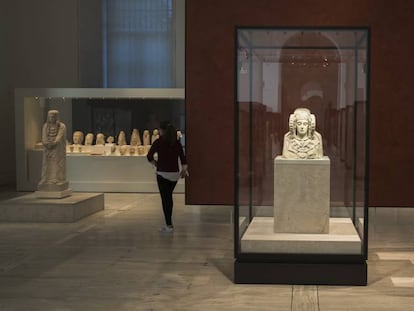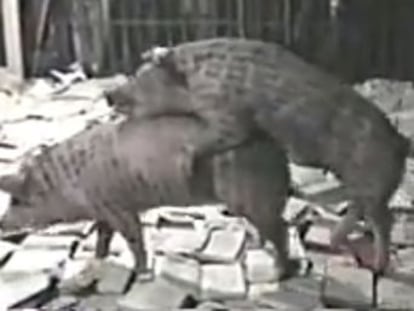The irreplaceable scientific treasures lost in Brazil’s National Museum blaze
A recent fire has destroyed some of South America’s oldest fossils, as well as irretrievable recordings of native languages no longer spoken
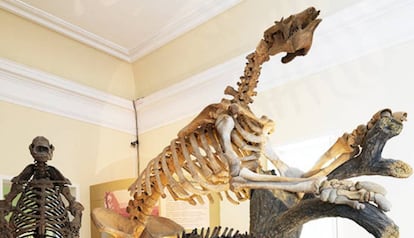
Among the ashes of Rio de Janeiro’s National Museum are what has survived of its unique cache of fossils, ceramics and rare species. Before a fire swept through its collection of prized exhibits, the museum was home to around 20 million examples of natural history, including skeletons that harbor the answers to questions that haven’t yet been answered – or in some cases even asked. The inferno may also have silenced forever the words and songs of indigenous peoples in languages that no one remembers anymore.
Three days after the fire, the full extent of the damage had still not been assessed
Three days after the fire, the full extent of the damage had still not been assessed. But both professors and students are pessimistic, with many facing the possibility that the object of their studies has gone up in smoke.
One of the main concerns is the potential damage done to the material taken from the archeological site Lagoa Santa, in the state of Minas Gerais, which is considered of fundamental importance to understanding the origin of prehistoric American communities. The largest assortment of this material in the world, it was the indisputable jewel in the museum’s crown.
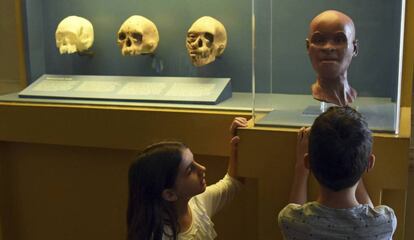
Labeled “the Luzia Group,” in reference to the oldest skeleton ever found in America, which came to light in 1974 and dates back 11,500 years, its discovery paved the way for a series of hypotheses concerning the colonization of the continent. Studies carried out on Luzia’s skull during the 1980s by Professor Walter Neves suggest that the first natives in America were possibly of African origin. As Luzia’s features do not resemble the features of Brazilian indigenous people at the time of its discovery, experts came up with the theory of an initial migration to Brazil of peoples with African characteristics who would have crossed from Asia to America via the Bering Strait 14,000 years ago, followed by another wave of migrants with Asiatic features, such as those of the American Indians, around 12,000 years ago. The delicate cranium was kept inside a steel case and it is not yet known what has become of it.
“There are smaller collections of material excavated from Lagoa Santa in the São Paulo University, the Federal University of Minas Gerais and in Copenhagen but they don’t amount to even half of what was here,” says Mercedes Okumura, the coordinator at the Laboratory for Human Evolutionary Studies at São Paulo University, who worked in the museum’s archives for four years. According to Okumura, the analysis that was being carried out on the skeletons and the research still waiting to be financed, such as the analysis of isotopes and the genome sequencing, could confirm the theory of the African migration to America.
This is material that no longer exists in any other museum in the world
Mercedes Okumura, São Paulo University
There were also fossils lining the museum’s passages suggesting that American Indians were direct descendants of the Polynesians. These were in the shape of around 40 nomadic Botocudo skeletons, a tribe that is now extinct. “This is material that no longer exists in any other museum in the world,” says Okumura.
The fire may also have destroyed research related to one of Brazil’s most peculiar communities: the Sambaquianos. These were an indigenous people who lived along the coast on top of mounds of shells and fish bones several meters high, called sambaquis, which also served as graves. Most of these sambaqui mounds have long since been removed and replaced by buildings. The museum, however, had an impressive collection of material relating to the Sambaquianos, such as skeletal remains, utensils and samples of the mounds themselves.
The silenced voices
The archives also contained recordings of conversations, songs and rituals from dozens of indigenous tribes, many taped on old machines during the 1960s, and which had not yet been digitalized. Some contained extinct languages, long since forgotten.
“We hope that other institutions have recordings of these languages,” says linguist Marilia Facó Soares, who works with the Tikuna tribe that make up the Brazilian Amazon’s largest community. She thinks that some of her own work has been lost in the fire. “I will have to repeat field work to fill in the gaps,” she says. “But obviously, you can’t recover the conversations of those already dead, generally the oldest members of the communities.”
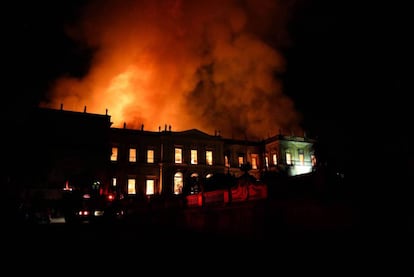
The museum also contained archives that were considered basic to the study of indigenous culture, such as those from Professor Roquette Pinto, who made the first known recordings of indigenous music with a phonograph in 1912; or the material from the German researcher Curt Nimuendajú who traveled to hundreds of villages that encompassed most of the country’s tribes in the first half of the 20th century, and who is considered the father of ethnology in Brazil. The museum kept the original negatives of his photographs, notes and other invaluable written material.
In the field of biology, the losses are incalculable, particularly in the area of invertebrates. “We had a hundred-year-old collection containing millions of different insects, among them thousands of type specimens that are the examples upon which the description of the entire species is based and which become the model [for each species], and they can’t be replaced,” says Ronaldo Fernandes, a professor associated with the museum’s vertebrate department. “It’s all been lost. The department that studies spiders, scorpions and ticks has been completely burned down.”
According to Fernandes, the collection of Malacology – the study of molluscs – has been saved thanks to one of the professors who rescued 80% of the type specimens from the collection while the building was in flames.
Some researchers watched their work reduced to cinders live on TV. “All the professors’ libraries have gone,” says Luiz Dias Duarte, anthropologist and associate director of the museum. “My archives, the notes from my field work, registers and tapes gathered over 40 years of research in Brazil as well as those still in progress, have been lost. We had the best anthropological library in Brazil. It’s all been reduced to ashes.”
English version by Heather Galloway.
Tu suscripción se está usando en otro dispositivo
¿Quieres añadir otro usuario a tu suscripción?
Si continúas leyendo en este dispositivo, no se podrá leer en el otro.
FlechaTu suscripción se está usando en otro dispositivo y solo puedes acceder a EL PAÍS desde un dispositivo a la vez.
Si quieres compartir tu cuenta, cambia tu suscripción a la modalidad Premium, así podrás añadir otro usuario. Cada uno accederá con su propia cuenta de email, lo que os permitirá personalizar vuestra experiencia en EL PAÍS.
¿Tienes una suscripción de empresa? Accede aquí para contratar más cuentas.
En el caso de no saber quién está usando tu cuenta, te recomendamos cambiar tu contraseña aquí.
Si decides continuar compartiendo tu cuenta, este mensaje se mostrará en tu dispositivo y en el de la otra persona que está usando tu cuenta de forma indefinida, afectando a tu experiencia de lectura. Puedes consultar aquí los términos y condiciones de la suscripción digital.
More information
Archived In
Últimas noticias
Trump clarifies who is ultimately in charge in Venezuela: ‘Me’
Maduro pleads not guilty before the federal court in New York: ‘I am still the president of Venezuela’
A new test can detect Alzheimer’s from a finger prick
UN team enters Sudanese city of El Fasher after paramilitary massacre: ‘It’s like a ghost town’
Most viewed
- Gilles Lipovetsky: ‘If you want to live better and fall in love, take Prozac, don’t look to philosophy’
- Alain Aspect, Nobel laureate in physics: ‘Einstein was so smart that he would have had to recognize quantum entanglement’
- Alvin Hellerstein, a 92-year-old judge appointed by Bill Clinton, to preside over Maduro’s trial in New York
- Why oil has been at the center of Venezuela-US conflicts for decades
- Cuba confirms death of 32 of its citizens in the US attack against Venezuela

